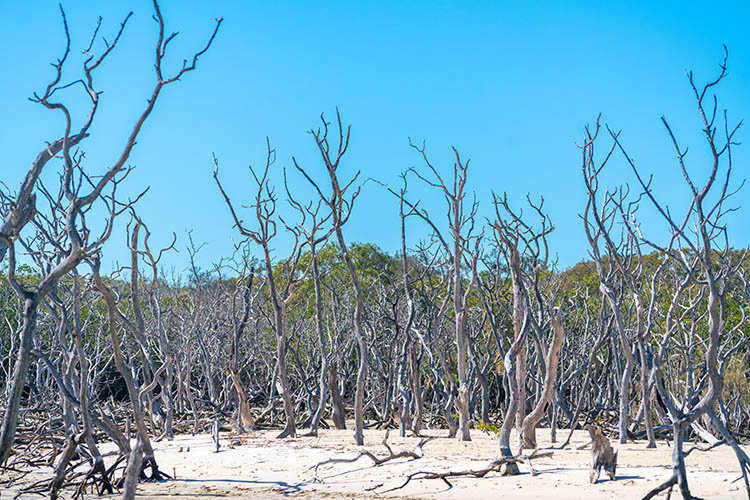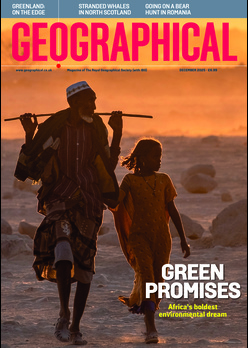
Dead and degraded mangroves are becoming more common thanks to climate change but could provide opportunities for all-important seagrass meadows, research finds
By Tom Howarth
As one door closes, another opens, or so the saying goes. And while human-induced climate change is ravaging ecosystems the world over, opportunities for the restoration of what’s left behind are emerging from the wreckage.
Last month, researchers from the University of Queensland published an important example of this in the journal Frontiers in Climate, identifying that dead or degraded mangrove forests, known as ‘ghost forests’, provide an ideal habitat for seagrass meadows.
‘This new understanding could shake up how we approach restoring these coastal ecosystems,’ said Alice Twomey, lead author of the study. ‘Instead of viewing ghost forests as dead ecosystems, we might start using them strategically to restore seagrass. It’s like turning negative outcomes into a positive twist for nature’s playbook.’
What are mangroves, and why are they dying?
Mangroves are coastal ecosystems consisting of salt-tolerant trees, shrubs and other plants that grow in the intertidal zones of tropical and subtropical regions. They play crucial roles in coastal environments, supporting a diverse array of marine life and protecting shorelines from erosion and storm surges.
Not only are mangroves biodiversity hotspots, but they are also powerful carbon sinks capable of sequestering carbon from the atmosphere at a rate ten times greater than that of mature tropical rainforests.

Unfortunately, mangrove forests are some of the most threatened ecosystems on the planet, with three-quarters of them now at risk globally, according to UNESCO chief Audrey Azoulay.
In many cases, mangrove habitats are completely cleared as humans expand ever further into the natural landscape. In others, however, extreme climatic events — storms, droughts, etc., made more common or severe as a result of anthropogenic greenhouse gas emissions — may degrade or destroy mangrove forests, leaving behind ghost forests like those studied in the paper.
Ghost forests are also cropping up as a consequence of global sea level rise. As the sea creeps inland, so do the mangroves, with those left stranded in deeper waters dying as water levels become too high for the plants to thrive.
‘Ghost forests are becoming more commonly reported because of climate change, and because they haven’t been around for very long, we don’t know a lot about them,’ Twomey said. With this in mind, her team began exploring sites in Moreton Bay, Queensland, an area that lost 3,379 hectares of mangroves between 2004 and 2007 alone.
Six sites were selected in all, each with dead mangroves, adjacent live mangroves and seagrass. The team found that where the mangroves had once stood, seagrass was now thriving. Moreover, they were able to characterise those sites best for seagrass restoration, finding that low canopy cover, low stem densities and water temperatures similar to those in adjacent meadows could make for the best habitat.
Why restoring seagrass is important
By now, you might be used to the notion of planting trees as a response to climate change. In the UK, for example, the government is aiming to plant 30,000 hectares of trees a year by the end of this parliament. Important work, but can we do better?
While trees take carbon from the atmosphere and store it in their biomass, wetland species such as seagrass can transfer it to sediment that accumulates around where they grow. This burying of organic carbon, known as ‘blue carbon’, happens at a rate 35 times faster than in tropical rainforests, and once there, the carbon can remain trapped for millennia.
Beyond being carbon sinks for our benefit, seagrass meadows, like mangroves, act as havens for wildlife. According to the WWF, seagrass can support 30 to 40 times more sea life than a patch of bare seafloor.
‘Additionally,’ Twomey explained, ‘seagrass provides a plethora of ecosystem services such as improving water quality, providing coastal protection (reducing erosion) and providing fish nurseries for fisheries species.’ She also pointed out that in Australia specifically, seagrass is vital for maintaining endangered populations of green sea turtles and dugongs.
But seagrass is under threat too. According to a 2020 report by the UN, ‘seven per cent of this key marine habitat is being lost worldwide per year’ — equivalent to a football field of seagrass lost every 30 minutes.
Restoring lost seagrass and growing new meadows is an easy win for the planet on paper, but it’s no easy feat in the real world. Planting is a laborious task often carried out by hand, and with survival rates of seagrass seeds reported to be as low as ten per cent finding the most productive locations could be vital for increasing the likelihood of success.

‘For restoration practitioners, this could open up exciting possibilities in some places,’ Twomey said. ‘Seagrass restoration in ghost forests, especially in favourable areas, could be a viable option for whole landscape restoration. These sites, if near dense seagrass meadows, might need fewer interventions, offering a practical approach to successful restoration in the face of changing sea levels.’
Ultimately, the results of this research pertain to a handful of sites in a relatively small locale, and more work is needed to establish whether similar patterns are observed elsewhere. ‘To translate this work to other areas around the world, we need to identify areas where seagrass and ghost forests exist close to each other,’ Twomey said, mentioning Florida and the Caribbean as possible sites for exploration.
In the meantime, the significance of this research extends beyond Moreton Bay in another way. As Twomey put it, the ‘work provides a message of hope, where if one ecosystem dies, another vulnerable ecosystem may be able to thrive’.




